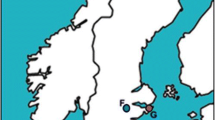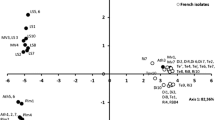Abstract
Peach and almond scab caused by Venturia carpophila and pecan scab caused by Fusicladium effusum result in yield loss, downgrading of fruit, defoliation and subsequent decline of an orchard. To understand the levels of genetic diversity and divergence of pathogens from different hosts and locations 51 isolates were genotyped and analyzed using 10 RAPD and 5 UP-PCR markers, including 18 isolates of V. carpophila from peach trees in the southeastern United States, 12 isolates of V. carpophila from almond trees in California, and 21 isolates of F. effusum (a related species) from pecan trees in the southeastern United States. The combined marker results showed a low incidence of polymorphisms among the peach isolates (4.2 % of markers), but a higher incidence of polymorphisms among the almond isolates (42.0 %) and the pecan isolates (61.0 %). The Dice coefficient of similarity ranged from 0.932 to 1.000 for the peach V. carpophila isolates, 0.214 to 0.976 for the almond V. carpophila isolates, and 0.528 to 0.920 for the pecan F. effusum isolates. UPGMA bootstrap values indicated that UP-PCR data were slightly more robust and, based on the combined data, the UPGMA bootstrap analysis (1,000 runs) gave a high node value (100 %) differentiating all the isolates of V. carpophila from F. effusum and a moderate node value differentiating the peach and almond isolates of V. carpophila (68 %). The results suggest some divergence between the V. carpophila populations of almond trees in California and peach tree populations in the southeastern United States, and different levels of genetic diversity within the two populations.






Similar content being viewed by others
References
Adaskaveg JA (2002) Scab. In: Teviotdale BL, Michailides TJ, Pscheidt JW (ed) Compendium of nut crop diseases in temperate zones - Part II. Almond diseases. APS Press, pp 29–30
Adaskaveg J, Gubler D, Michailides T (2013) Fungicide, bactericide, biological tables for fruit, nut, strawberry, vine crops. University of California, pp 1–54 http://www.ipm.ucdavis.edu/PDF/PMG/fungicideefficacytiming.pdf
Arnau J, Housego AP, Oliver RP (1994) The use of RAPD markers in the genetic analysis of the plant pathogenic fungus Cladosporium fulvum. Curr Genet 25:438–444
Baskarathevan J, Jaspers MV, Jones EE, Cruickshank RH, Ridgway HJ (2012) Genetic, pathogenic diversity of Neofusicoccum parvum in New Zealand vineyards. Fungal Biology 116:276–288
Beck A, Ritschel A, Schubert K, Braun U, Triebel D (2005) Phylogenetic relationships of the anamorphic genus Fusicladium s. lat. as inferred by ITS nrDNA data. Mycol Prog 4:111–116
Beigmohamadi M, Rahmani F (2011) Genetic variation in hawthorn (Crataegus spp.) using RAPD markers. Afr J Biotechnol 10:7131–7135
Bertrand PF (2002) Scab. In: Teviotdale BL, Michailides TJ, Pscheidt JW (ed) Compendium of nut crop diseases in temperate zones - Part IV. Pecan diseases. APS Press, pp 55–57
Bock CH, Thrall PH, Burdon JJ (2005) Genetic structure of populations of Alternaria brassicicola suggests the occurrence of sexual recombination. Mycol Res 109:227–236
Bock CH, Endalew TT, Biswas BK, Yadav AK, Sitther V, Hotchkiss MW, Stevenson KL, Wood BW (2014a) A comparison of UP-PCR, RAPD markers to study genetic diversity of the pecan scab fungus (Fusicladium effusum G. Winter). Forest Pathology: doi: 10.1111/efp.12090
Bock CH, Stevenson KL, Arias RS, Wood BW (2014b) Genetic diversity, population structure of Fusicladium effusum on pecan in the U.S.A. Plant Disease. Accepted
Borie B, Jacquiot L, Jamaux-Despréaux I, Larignon P, Péros J-P (2002) Genetic diversity in populations of the fungi Phaeomoniella chlamydospora, Phaeoacremonium aleophilum on grapevine in France. Plant Pathol 51:85–96
Bulat SA, Lübeck M, Mironenko N, Jensen DF, Lübeck PS (1998) UP-PCR analysis, ITS1 ribotyping of strains of Trichoderma, Gliocladium. Mycol Res 102:933–943
Cumagun CJR, Hockenhull J, Lübeck M (2000) Characterization of Trichoderma isolates from Philippine rice fields by UP-PCR, rDNA-ITS1 analysis: identification of UP-PCR markers. J Phytopathol 148:109–115
Ellsworth DL, Rittenhouse KD, Honeycutt RL (1993) Artifactual variation in randomly amplified polymorphic DNA banding patterns. BioTechniques 14:214–217
Excoffier L, Laval G, Schneider S (2005) Arlequin ver. 3.0: An integrated software package for population genetics data analysis. Evol Bioinformatics Online 1:47–50
Fisher EE (1961) Venturia carpophila sp. nov, the ascigerous state of the apricot freckle fungus. Trans Br Mycol Soc 44:337–342
Gallego FJ, Pérez MA, Núñez Y, Hidalgo P (2005) Comparison of RAPDs, AFLPs, SSR markers for the genetic analysis of yeast strains of Saccharomyces cerevisiae. Food Microbiol 22:561–568
Gladieux P, Zhang X-G, Róldan-Ruiz I, Caffier V, Leroy T, Devaux M, van Glabeke S, Coart E, Le Cam B (2010) Evolution of the population structure of Venturia inaequalis, the apple scab fungus, associated with the domestication of its host. Mol Ecol 19:658–674
Guo Y-D, Yli-Mattala T, Pulli S (2003) Assessment of genetic variation in Timothy (Phleum pretense L.) using RAPD, UP-PCR. Hereditas 138:101–113
Hampl V, Pavlíček A, Flegr J (2001) Construction, bootstrap analysis of DNA fingerprinting-based phylogenetic trees with the freeware program FreeTree: application to trichomonad parasites. Int J Syst Evol Microbiol 51:731–735
Leal AA, Mangolin CA, do Amaral Junior AT, Gonçalves LSA, Scapim CA, Mott AS, Eloi IBO, Cordovés V, da Silva MFP (2010) Efficiency of RAPD versus SSR markers for determining genetic diversity among popcorn lines. Genet Mol Res 9:9–18
Lewontin RC (1972) The apportionment of human diversity. Evol Biol 6:381–398
Lübeck PS, Alekhina IA, Lubeck M, Bulat SA (1998) UP-PCR Genotyping, rDNA Analysis of Ascochyta pisi Lib. J Phytopathol 146:51–55
Luo Y, Hou L, Förster H, Adaskaveg JE (2013) QoI resistance in Fusicladium carpophilum populations from almond in California, evaluation of molecular resistance mechanisms. Plant Dis 97:1322–1330
Mantel N (1967) The detection of disease clustering, a generalized regression approach. Cancer Res 27:209–220
McDonald BA, Linde C (2002a) Pathogen population genetics, the durability of disease resistance. Euphytica 124:163–180
McDonald BA, Linde C (2002b) Pathogen population genetics, evolutionary potential, durable resistance. Annu Rev Phytopathol 40:349–379
Mofokeng MA, Watson G, Shimelis H, Tongoona P (2012) Comparison between random amplified polymorphic DNA (RAPD), simple sequence repeat (SSR) markers with high resolution melt analyses in genetic variation analysis among selected sorghum genotypes. Afr J Biotechnol 11:16697–16707
Myśków B, Milczarski P, Masojć P (2011) Comparison of RAPD, ISSR, SSR markers in assessing genetic diversity among rye (Secale cereale L.) inbred lines. Plant Breeding. Seed Science 62:107–115
National Agricultural Statistics Service (2013) Noncitrus fruits, nuts. 2012 Preliminary summary (January 2013) 79 USDA, National Agricultural Statistics Service. http://usda01.library.cornell.edu/usda/nass/NoncFruiNu//2010s/2013/NoncFruiNu-01-25-2013.pdf
Nei M (1973) Analysis of gene diversity in subdivided populations. Proceedings of the National Academy of Sciences, USA, 70:3321–3323
Nei M, Li W-H (1979) Mathematical model for studying genetic variation in terms of restriction endonucleases. Proc Natl Acad Sci U S A 76:5269–5273
Novelo ND, Gomelsky B, Pomper KW (2010) Inheritance, reliability of random amplified polymorphic DNA-markers in two consecutive generations of common carp (Cyprinus carpio L.). Aquac Res 41:220–226
Obanor FO, Walter M, Jones EE, Candy J, Jaspers MV (2010) Genetic variation in Spilocaea oleagina populations from New Zealand olive groves. Australas Plant Pathol 39:508–516
Ogawa JM, English H (1991) Diseases of temperate zone tree fruit, nut crops. Univ. of Calif, Div. of Agr., Natural Resources, Oakland, Calif. Publ. 3345
Page RDM (1996) TREEVIEW: An application to display phylogenetic trees on personal computers. Comput Appl Biosci 12:357–358
Partridge EC, Morgan-Jones G (2003) Notes on Hyphomycetes. xc. Fusicladosporium, a new genus for Cladosporium-like anamorphs of Venturia, the pecan scab-inducing fungus. Mycotaxon 85:357–370
Pavlíček A, Hrdá Š, Flegr J (1999) FreeTree – freeware program for construction of phylogenetic trees on the basis of distance data, for bootstrap/jackknife analysis of the trees robustness Application in the RAPD analysis of genus Frenkelia. Folia Biol 45:97–99
Pezhmanmehr M, Hassani MI, Jahansooz F, Najafi AA, Sefidkon F, Mardi M, Pirseiedi M (2009) Assessment of genetic diversity in some Iranian populations of Bunium persicum using RAPD, AFLP markers. Iran J Biotechnol 7:93–100
Pottinger B, Stewart A, Carpenter M, Ridgeway HJ (2002) Low genetic variation detected in New Zealand populations of Phaeomoniella chlaydospora. Phytopathology Mediterannea 41:199–211
Powell W, Morgante M, Andre C, Hanafey M, Vogel J, Tingey S, Rafalski A (1996) The comparison of RFLP, RAPD, AFLP, SSR (microsatellite) markers for germplasm analysis. Mol Breed 2:225–238
Salamati S, Zhan J, Burdon JJ, McDonald BA (2000) The genetic structure of field populations of Rhynchosporium secalis from three continents suggests moderate gene flow, regular recombination. Phytopathology 90:901–908
Sánchez-Torres P, Hinarejos R, Tuset JJ (2009) Characterization, pathogenicity of Fusicladium eriobotryae, the fungal pathogen responsible for loquat scab. Plant Dis 93:1151–1157
Scherm H, Brannen PM (2005) Peach scab. In: Horton D, Johnson D (eds) Southeastern Peach Growers’ Handbook. University of Georgia, College of Agricultural, Environmental Sciences, Athens, pp 134–136
Schnabel G, Schnabel EL, Jones AL (1999) Characterization of ribosomal DNA from Venturia inaequalis, its phylogenetic relationship to rDNA from other tree-fruit Venturia species. Phytopathology 89:100–108
Schubert K, Ritschel A, Braun U (2003) A monograph of Fusicladium s. lat. (Hyphomycetes). Schlechtendalia 9:1–132
Seyran M, Nischwitz C, Lewis KJ, Gitaitis RD, Brenneman TB, Stevenson KL (2010) Phylogeny of the pecan scab fungus Fusicladium effusum G. Winter based on the cytochrome b gene sequence. Mycol Prog 9:305–308
Sivanesan A (1977) The taxonomy, pathology of Venturia species. Bibl Mycol 59:1–139
Strand LL (1999) Integrated pest management for stone fruit. University of California Division of Agriculture, Natural Resources. Publication 3389:132
Tenzer I, Gessler C (1999) Genetic diversity of Venturia inaequalis across Europe. Eur J Plant Pathol 105:545–552
USDA (2004) United States standards for grades of peaches. United States Department of Agriculture. Agricultural Marketing Service. Fruit, Vegetable Programs – Fresh Products Branch. P6) http://www.ams.usda.gov/AMSv1.0/getfile?dDocName=STELPRDC5050385
Wang XR (1997) Genetic variability in the canker pathogen fungus, Gremmeniella abietina. contribution of sexual compared with asexual reproduction. Mycol Res 101:1195–1201
Wang P, Lu Y, Zheng M, Rong T, Tang Q (2011) RAPD, internal transcribed spacer sequence analyses reveal Zea nicaraguensis as a section Luxuriantes species close to Zea luxurians. Plos One 6, e16728) doi:10.1371/journal.pone.0016728
Williams JGK, Kubelik AR, Livak KJ, Rafalski JA, Tingey SV (1990) DNA polymorphism amplified by arbitrary primers are useful as genetic markers. Nucleic Acids Res 18:6531–6535
Xu X, Harvey N, Roberts A, Barbara D (2013) Population variation of apple scab (Venturia inaequalis) within mixed orchards in the UK. Eur J Plant Pathol 135:97–104
Yeh C, Yang RC, Boyle T (1999) Popgene Version 1.32) Microsoft Windows-based freeware for population genetic analysis. http://ualberta.ca/~fyeh/index.htm
Acknowledgments
We appreciate the technical assistance of Minling Zhang and Wanda Evans for pathogen isolation and molecular work. We also appreciate the samples sent by Norman Lalancette (Rutgers University, NJ), Keith Yoder (Virginia Tech University), Guido Schnabel (Clemson University, SC), Kari Peter (Penn State University, PA), Nicole Gauttier (University of Kentucky), Tom Beckman (USDA-ARS, GA), Leigh-Ann Fall (University of Georgia), Mary Olmstead (University of Florida), and the pecan growers who allowed us access their orchards to collect samples of F. effusum.
This article reports the results of research only. Mention of a trademark or proprietary product is solely for the purpose of providing specific information and does not constitute a guarantee or warranty of the product by the U.S. Department of Agriculture and does not imply its approval to the exclusion of other products that may also be suitable.
Author information
Authors and Affiliations
Corresponding author
Rights and permissions
About this article
Cite this article
Chen, C., Bock, C.H., Brannen, P.M. et al. Genetic variability among populations of Fusicladium species from different host trees and geographic locations in the USA. Mycol Progress 13, 1006 (2014). https://doi.org/10.1007/s11557-014-1006-y
Received:
Revised:
Accepted:
Published:
DOI: https://doi.org/10.1007/s11557-014-1006-y




